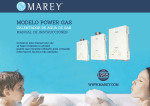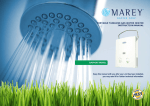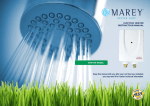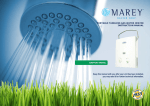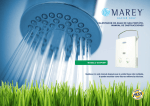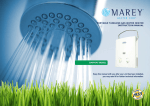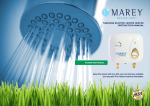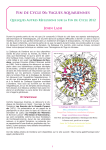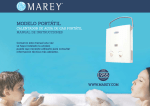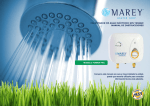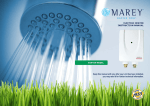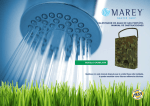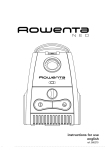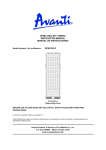Download Marey POWER GAS 5L Installation manual
Transcript
Congratulations! You've just purchased a new Marey Power Gas tankless water heater and will soon begin to enjoy the benefits of “going tankless.” The availability of instant hot water, combined with the unit's outstanding energy efficiency and space saving design, will quickly convince you that you've made the best decision for meeting your home's hot water needs. Take the time to thoroughly read and understand this safety and installation manual in its entirety before you attempt to install your new Power Gas tankless water heater, as it contains important safety tips and instructions. Please carefully read all instructions and warnings. Should you have any questions, please visit www.marey.com for installation videos and FAQ. Please keep this manual for future reference. WARNING: If you are not familiar with basic plumbing and electricity, we highly recommend that you employ the services of a professional to assist you with this installation. Under no circumstances should you attempt to install, repair, ordisassemble the Marey Power Gas water heater without firsts hutting off any gas supplied to the unit. 02 QUICK START GUIDE 04 PACKING LIST 05 IMPORTANT WARNINGS 05 FUNCTIONS AND FEATURES 06 INSTALLATION 08 OPERATING INSTRUCTIONS 13 INSTRUCTIONS FOR DAILY MAINTENANCE 14 CONSTRUCTION AND PART IDENTIFICATION 15 TECHNICAL PARAMETERS 17 TEMPERATURE INCREASE CHART 17 TROUBLESHOOTING GUIDE 18 CUSTOMER SERVICE 19 OTHER PRODUCTS 19 03 POWER GAS MODELS **WARNING: working with gas can be dangerous. If you are not familiar with local building codes and basic gas plumbing practices please employ a professional to install your water heater** 1. Water heater-Qty 1 2. Operating Instructions-Qty 1 3. Mounting Screws-4 Sets 1- Securely mount your water heater to the wall in an appropriate location using the supplied hardware. - You MUST install this water heater according to all directions and specifications contained in this manual. Failure to properly install the heater can result in property damage or severe injury or death by burning, explosion, or asphyxiation due to carbon monoxide. 2- Install the venting (4” for 5L or 10L units, 5” for 16L units) per local building codes and the instructions supplied. - You MUST check the exhaust flue for obstructions at the initial installation and at least annually thereafter. 3- Connect the gas lines (all connections are ½”). Use yellow Teflon tape at threaded connections. Check carefully for gas leaks using soapy water and correct as necessary before proceeding further. - You MUST check all connections for gas leaks with soapy water before firing the unit. This must be done at the initial install and after every propane bottle change if using an LP model. If you detect a gas leak of any kind, DO NOT fire up your unit. 4- Connect the water lines (all connections are ½”). Use ½” or ¾” pipe or tubing for the water supply and return. If water pressure or flow rates are questionable use ¾” lines to ensure maximum flow. You MUST use copper, CPVC or appliance tubing intended for use in hot water applications for all hot water lines. - You MUST check for gas leaks by smell. Understand that LP is heavier than air and may sink to ground level. If you detect a gas leak of any kind, DO NOT fire up your unit. 5- Check for and correct water leaks as necessary. - You MUST observe the unit in operation for several cycles before leaving it unattended. 6- Install the batteries in the battery compartment. Be sure the polarity of the batteries is correct. - Unit MUST be hung vertically, with the water and gas connections at the bottom and the exhaust at the top. 7- Turn on the faucet and adjust the water and gas settings on the water heater as needed for your specific environment and comfort. **USE CAUTION NOT TO GET SCALDED WHILE ADJUSTING YOUR SETTINGS** Remember that more water flow will usually result in less heating, and vice versa. Higher gas settings result in more heating, and vice versa. - You MUST use a carbon monoxide detector in conjunction with this, or any, gas burning appliance. 8- Begin enjoying instant, energy efficient hot water for years to come! Disclaimer: This document is intended as a quick reference only and does not contain all of the important safety warnings and other information necessary to safely operate your heater. For a complete list of safety warnings and instructions please reference the instruction manual before operating your water heater. - Do NOT expose the water heater to strong wind (including that from fans) or rain. - Do NOT install the water heater near flammable or volatile substances. Do not handle or store these substances near the heater (gasoline, acetone, motor oil, paint thinners or any other flammable or volatile substance). - Do NOT use tubing or piping that is aging or cracked in any way. - Do NOT use this appliance with any type of gas other than that indicated on the data plate located on the side of the unit. Death or severe injury may result. - Do NOT attempt to modify the internal components of this appliance. 04 05 - Do NOT install the water heater in a sealed room or in a room with poor air circulation. - You MUST install the exhaust pipe to properly discharge the exhaust gases. - Do NOT block the exhaust pipe or the air inlet at any time. This can cause incomplete combustion and can lead to gas poisoning. - When the water heater is in use, do NOT touch the body of the heater. Touch the knobs only, as the body of the heater can become very hot to the the touch. - Prevent scalds! While using the water heater, always check the water temperature and adjust as needed before use. WARNING! There is water contained in the coils of your water heater at all times. If your water heater is exposed to freezing temperatures, the water in the coils could freeze, causing a break in the heat exchanger of the unit, or the supply and return lines. This kind of damage will result in water running freely into the space where the water heater is located, with can cause flooding. If your water heater is installed in a geographic location that sees very low sustained temperatures, you MUST install a backflow preventer on your heater's vent pipe. This will ensure that cold air cannot fall down into the water heater and cause freezing damage. DO NOT install this water heater where it may be subjected to a freeze. If your water heater is in an area where freezing is a possibility, you must turn off the water to the heater and drain it of any water by using the valve stem at the bottom of the unit and disconnecting the warm water line. Leave the valve stem and the warm water line disconnected until you intend to use the water heater. 1. Water - controlled automatic ignition: When water flow is detected, heating is provided immediately with a doubleignition device. The flame is sensed by ions. This sensitive control makes the unit easy and convenient to operate. 4. Low water pressure start up function: This unit requires only 8 PSI to fire, making it suitable for users with low water pressure, or those who are using it to supply hot water to upper floors. Please note that the water flow and water pressure are not the same. Sufficient flow is always required to keep the overheat safety sensor from shutting the unit off. 5. Anti - freezing protection: When the temperature is below freezing, remove the water discharge valve to discharge accumulated standing water inside the internal pipes. This will keep the unit from freezing. 6. Anti-dry combustion protection: Should dry combustion occur for any reason, the gas supply will be immediately and automatically shut off. 7. Over-pressure protection: When water pressure is over 145 PSI, the unit will automatically relieve the excessive pressure to avoid damage to its internal components. PRECAUTIONS: 1. The water heater must be installed in a well-ventilated area. An exhaust pipe of double walled steel for Class 3 appliances (located at most home improvement stores in the water heater section) must be installed to discharge the exhaust from the flame. During operation, the water heater consumes a lot of oxygen, so the exhaust pipe and outlet hole must be properly installed. Refer to exhaust pipe section for details. - Failure to properly install the room intake and exhaust pipe will cause oxygen depletion in the area around the water heater, which can cause incomplete combustion. Carbon monoxide poisoning, death and serious accidents can occur due to incomplete combustion. ALL USERS OF GAS APPLIANCES OF ANY TYPE SHOULD EMPLOY THE USE OF A CARBON MONOXIDE DETECTOR. Exhaust fan 2. Auto - cut off protection: The auto-cut-off protection will shut off the gas supply immediately if the flame goes out for any reason. 3. Energy savings: The advanced combustion system comes with a Winter/Summer switch. In winter, when incoming water temperatures are lower, the winter setting increases the size of the flame to compensate with extra heating. In summer, when incoming water temperatures are higher, the summer setting reduces the flame.This provides more comfort and energy savings in the form of lower gas consumption in warmer months. 06 There shall be a air inlet and a exhaust outlet. Air inlet Drawing 01 07 c) Install the expansion bolt into the drilled hole. Hang the unit utilizing the screws supplied. Washer The water heater must not be installed outside. Drawing 03 25" Drawing 02 Nut 29" The water heater must not be exposed to strong wind. Expansion Screw 2. Don´t expose the water heater to the strong wind or rain. 18" Heater Case 3. Use only the type of gas that is specified on the name plate. 4. All gas connections should be made by a professional. 5" 7,5" 5. Don't use pipes, tubing or other connections that are aging or cracked. 6. Do not use with water pressures lower than 8 PSI. Do not use with lower GPM's than indicated on the flow chart for your unit. 7. The water heater shouldn't be installed above cooking appliances, such as ovens or stoves. 8" Drawing 04 Water Supply Connect the cold water inlet supply Note: Use white Teflon tape at all threaded water connections 8. The water heater should be installed a minimum of 15 feet from any stairs or emergency exits. 9. The water heater must be installed vertically, according to the mounting instructions. 10. The water heater must not be installed near flammable or volatile substances. Mounting Your Water Heater a)When possible, your water heater should be mounted directly to studs. There should be a screw in every available mounting location on the heater. If studs are not available, do NOT hang unit directly from sheetrock without utilizing expansion screws. b) When utilizing expansion screws for sheetrock mounting, hold the unit on the wall where you want it mounted. Mark with a pencil the (4) mounting holes. Remove the unit from the wall, and drill 3/8” holes on each mark. (See drawings below). 08 - The cold water inlet joint is ½” NPT threaded pipe. - The water inlet should be connected by using flexible heavy duty tubing or rigid PVC pipe. If you choose flexible tubing, you will need a ½” threaded male to ½” hose barb adapter. Tubing should be secured with properly sized hose clamps. Rigid pipe should be ½” male threads. Teflon tape should be employed with any threaded fittings. - The inner diameter of the inlet pipe (including the valve) should not be less than 3/8”. Larger diameter pipe is acceptable with the appropriate adapters to reduce to ½” at the inlet joint. - The cold water valve must be installed inline with the water inlet pipe. - Always flush a new unit with water to clear out any collected deposits or debrisprior to installation. The supplied screen filter must be correctly installed in the cold water inlet to prevent mineral deposits from your water supply from building up in the unit's water valve assembly. After flushing with cold water and confirming that there is no residue in the pipe, install the rubber gasket and tighten the water inlet joint. 09 Hot Water Outlet - The hot water outlet joint is 1/2”NPT pipe thread. - The hot water outlet should be connected by flexible tubing or rigid PVC of the type intended for use with hot water. - The inner diameter of the water outlet pipe (including the valve) shouldn´t be less than 3/8”. Larger diameter pipe is acceptable as long as the appropriate adapters are used. - After connecting, fully open the cold water supply to confirm the flow of water and to check for leaks. Correct leaks as necessary. Installing the Gas Supply The gas inlet joint is 1/2”NPT pipe thread. Very Important: Use Teflon tape for gas or gas pipe paste between the unit and the gas inlet pipe connector. -For small bottle Liquid Propane installations: Connect the gas supply to your propane bottle using a standard rubber Liquid Propane hose and low pressure regulator. Optimal pressure for your unit is .41-.5 PSI, the same as a typical gas grill. Pressures set outside this range may result in inconsistent behavior from your water heater. This kind of damage will result in water running freely into the space where the water heater is located, with can cause flooding. If your water heater is installed in a geographic location that sees very low sustained temperatures, you MUST install a backflow preventer on your heater's vent pipe. This will ensure that cold air cannot fall down into the water heater and cause freezing damage. Damage to the unit or residence caused by freezing is not covered under warranty and responsibility for this type of damage is disclaimed by Marey Heater Corporation. - All venting must be done in accordance with local codes and regulations. Local building codes from city to city and state to state will vary. Some jurisdictions may allow venting material not allowed by other jurisdictions. - ALL jurisdictions in North America allow for Z-Vent material to be used for venting tankless hot water heaters. The condensation of a tankless water heater is slightly more acidic than that of a standard water heater. Z-Vent is double walled stainless steel vent pipe made specifically for venting tankless heaters. Z-Vent is intended for lifetime use and will never corrode or rust. - Z-Vent material is available at most home improvement stores, and can be found at many online retailers as well. - SOME jurisdictions in North America allow for B-Vent to be used. B-Vent is double walled galvanized vent pipe made for standard water heaters and stove vent pipe. B-Vent is not lifetime material and will eventually corrode after extended use. Before deciding what material to use, you MUST check your local building codes to see what is allowed in your jurisdiction. If you choose to use B-Vent, you MUST check it at least monthly for corrosion and replace vent pipes immediately if corrosion is detected. - For whole house Liquid Propane or Natural Gas Installations: The unit should be connected directly to the home gas supply using black iron gas pipe or the braided metal gas appliance hoses located in the water heater section of your local home improvement store. WARNING: THIS TYPE OF CONNECTION MUST BE MADE BY A PROFESSIONAL. Please note that Natural Gas units require .25-.5 PSI for your unit to operate correctly. If you are unsure of your gas pressure, contact your gas company. - Diameter of the vent pipe is 4” for 5L, 4” for 10L, and 5” for 16L units. Use the coupler provided with your unit for installation on the 5L and 10L units. Vent pipe attaches directly to the unit in 16L models. After the gas inlet is connected, open the gas supply valve and check for gas leaks at all connections by spraying with soapy water and watching for bubbles. Do not skip this step! Adjust or repair leaks as needed. - Through wall installations: Use (2) 45 degree elbows, (1) piece of straight pipe no longer than 18” in length, one piece of straight pipe no longer than 42” in length, one wind/rain cap and one condensation drain. - All gas connections must be made in accordance with local building codes and regulations. - From the outlet at the top of the water heater, attach the first 45 degree elbow with a vent pipe coupler to secure it to the unit. Once the elbow is attached, use it as a guide to cut a hole through the wall at a 45 degree upward angle, at a slightly larger diameter than the outlet pipe. Install the 18” piece of straight pipe to the 45 degree elbow and pass it through the hole in the wall. Note: If the overall thickness of your wall exceeds 18”, the length of the first pipe can be extended up to 24”. If this is the case, reduce the length of the second pipe to 36”. Total venting distance should not exceed 60”. Installing the Exhaust Pipe WARNING! There is water contained in the coils of your water heater at all times. If your water heater is exposed to freezing temperatures, the water in the coils could freeze, causing a break in the heat exchanger of the unit. 10 11 - Attach the second 45 degree elbow on the other side of the wall, turning the angle upward to run parallel with the wall. Install the second piece of flute pipe into the elbow, parallel to the outside wall. Utilize galvanized steel brackets or clamps as necessary to secure the piping. Install the rain/wind cap on top of the second piece of exhaust pipe.. - Install a condensation drain on the portion of pipe located outside the structure. - Through the roof installations: Use one piece of straight pipe, 60” or shorter, a wind/rain cap and a condensation drain. Attach directly to the outlet of the unit (16L units), or using the coupler supplied (5L and 10L units). - Drill a hole through the roof and ceiling slightly larger than the vent pipe diameter. Attach pipe to the top of the unit and go straight up and out the roof. Install rain/wind cap on top of vent pipe. Total vertical distance must not exceed 60”. Roof clearance must be at least 12”. - Fresh air intake: The room in which the heater is located must have an air inlet not less than .75 square feet (roughly 9” x 12” or larger). Wind/rain cap Straight pipe 42" or less Straight pipe 18" or less Coupler (island 10L only) 45º elbow Outlet - After installation is complete, open the battery compartment located at the bottom of the unit and install two D Cell batteries. Check the door of the battery compartment for correct battery position. - Open the hot water on a nearby faucet. Confirm proper water flow through the unit and out of the faucet. (You should hear a “clicking” sound from the unit-this is the ignitor activating). Turn the water back off. - Start the gas supply. Check again for gas leaks using soapy water and correct as necessary. - Open the hot water faucet. You should hear the ignition clicking, and hot water should begin flowing. Sometimes, if there is air in either the water or gas supply lines, you will not get immediate combustion. If this is the case, turn the water on and off several times to clear the water and gas lines of any air pockets that may be present. - All water heaters have a seasonal summer/winter switch to meet your water temperature needs. This is because extra heating may be required when incoming water temperatures are lower (winter), and less heating is required when incoming water temperatures are higher (summer). Use the summer setting when incoming water temperatures are a little higher. Use the winter setting when incoming water temperatures are a little lower. - When the water supply is turned off, the water heater will stop working. When you turn the water back on, the water heater will reignite. Please note that if you use the hot water multiple times in quick succession, the water may be excessively hot for one or two seconds. Please wait for the temperature to adjust before using. - If you close the water inlet valve or the water outlet valve, the water heater will shut off immediately. Shut off the gas supply after use. Water heater Wall Cap Through Roof Straight pipe 12" min Specification Roof 60" max Ceiling Coupler (5L and 10L units) Sighting Window Winter/Summer knob Instruction Gas controlling knob Water controlling knob Outlet Water heater Drawing 05 (D). Water heater type D (Drawing 1) **Note: If your situation requires a vent pipe distance of longer than 60”, a low CFM duct booster fan may need to be employed to ensure proper venting of the unit. 12 13 Sighting Window Specification Do NOT use strong detergents, benzene, gasoline, or other flammable agents to clean the unit. Winter/Summer knob Instruction Regularly remove and wash the stainless steel filter in the cold water inlet. Gas controlling knob Water controlling knob During operation, take note of the flame and discontinue use if abnormal combustion is detected. Avoid accidents. DO NOT modify this unit in any way. Drawing 06 1. If a gas leak is detected at any time, close the main gas valve immediately. The Marey service center or your local gas company should be contacted for repair. 5L and 10L units 2. Before going to sleep or leaving the house, the gas supply should be shut off. 3. Do not block the exhaust pipe or the air inlet. This can cause incomplete combustion and lead to gas poisoning. 4. During operation, check the fire through the sight glass for normal combustion. Check for a compact, blue flame. Tall or excessively orange flames indicate abnormal combustion. If there is abnormal combustion, close the gas valve immediately and contact the Marey service center or your gas company for maintenance. 5. When outdoor temperatures are below 32 degrees F and pipe freezing may occur, any water remaining in the unit after use should be discharged to avoid freezing. Water should be discharged in the following manner: Back plate Gas -collecting roof Heat exchanger Temperature controller Burner Ignition pin I Ignition pin II a) Turn off the gas supply valve, turn off the tap water supply valve, and turn the water temperature adjusting switch to the low temperature position. Turn on the hot water supply valve and remove the water discharge valve to discharge the water remaining in the unit. Reinstall the water discharge valve. Thermocou Gas adjusting valve Water adjusting valve Solenoid valve Check the gas pipes, hoses, and vent pipes regularly. If you find joints that are not tightly secured or if there are cracks or corrosion anywhere, you should stop using the heater and perform the necessary maintenance immediately. Microactive switch Ignition module Hot water outlet pipe Battery box Water discharge valve Gas inlet pipe Check regularly for water or gas leaks and correct immediately. Regularly clean the surface of the water heater to remove dirt or dust with a wet cloth, and then use a dry cloth to remove moisture. For hard to remove dirt, please use a mild spray cleaner or detergent. 14 Water inlet pipe Drawing 07 15 16L units IMPORTANT WARNING - PLEASE TAKE NOTE If your unit is a 16L model, you MUST follow this diagram for correctly connecting water and gas to the unit. The water and gas connection diagram contained on the previous page accurate only for the 5L and10L Power Gas models. If you have a 5L or 10L unit, please follow the diagram contained on the previous page. TECHNICAL SPECIFICATIONS GAS 5L GAS 10L GAS 16L Hot Water Outlet per Minute 5 LPM / 1.3 GPM 10 LPM / 2.7 GPM 16 LPM / 4.2 GPM Heat Loss 34,614 BTU/h 79,228 BTU/h 111,903 BTU/h Activation Flow Rate 10 PSI 10 PSI 10 PSI Maximmum Flow Rate 2 GPM 3.1 GPM 4.3 GPM Width x Height x Depth 11,4" x 17" x 4,7" 13,6" x 23,6" x 6,9" 6,5" x 27,9" x 18,2" Weight 11 lbs 29 lbs 21 lbs Gas Type Liquid Propane Gas or Natural Gas Related Gas Pressure (PSI) 0.25 up to 0.5 PSI (NG) & 0.4 (LPG) Exhaust Discharge Mode Flue Duct Type Aplicable Water Pressure 3.6 - 145.0 PSI / 0.25 - 10 bar Ignition 2D Cell Battery Powered (not included) Energy Efficiency 54% - 87% * No need for electricity, starts with pulse ignition, powered by 2 D cell batteries. TEMPERATURE INCREASE PER GPM Model GA5L Gas 0.5 1.0 1.5 2.0 2.5 2.7 3.0 3.5 4.0 4.3 Setting GPM GPM GPM GPM GPM GPM GPM GPM GPM GPM Highest 129º 64º 43º 32º - - - - - - Lowest 34º 11º 9º - - - - - - 100º 67º 50º 40º 37º 30º - - - 34º 23º 17º 14º 13º 9º - - - 143º 95º 71º 57º 52º 48º 41º 36º 33º 44º 22º 18º 16º 15º 13º 11º 10º Highest - 17º GA10L Lowest 68º GA16L Highest - Lowest 88º 29º *Highest gas setting: set for Winter/High *Lowest gas setting: set for Summer/Low *With and without LCD panels. Note: If your gas model features an LCD panel, the digital display will indicate the outgoing water temperature. Gas inlet pipe Hot water outlet pipe Water inlet pipe Drawing 08 16 This information is intended as a guideline based on typical residential environments. Temperature increases will vary depending on the environment in which the heater is used. Variables such as very low incoming water temperature or higher than average gas pressure can result in higher temperature increases. Higher incoming water temperature or lower than average gas pressure can result in lower temperature increases. ALWAYS test the water with your hand to confirm suitable temperature before use. Temperature increases listed are based on use of the water heater under optimal conditions with an incoming water temperature of 48ºF. Variable factors such as incorrect or imperfect installation or warmer incoming water temperature may yield different results. 17 At Marey, we pride ourselves on the excellence of our customer service and support team. Please feel free to contact us if you have any questions about our products, warranty service, or if you need assistance installing a unit. We also strive for continuous improvement, so we welcome your comments, feedback and suggestions. 1-855-MAREY-55 [email protected] Marey proudly manufactures water heaters and accessories for use in almost any application. Please visit our website to learn more about other Marey products. Not enough water flow through the unit Increase water flow through the unit Delbrey Street, 211 San Juan, Puerto Rico 00912 Tel: 1-512-332-2229 Toll Free: 1-855-627-3955 1-855-MAREY-55 www.marey.com 18 19










